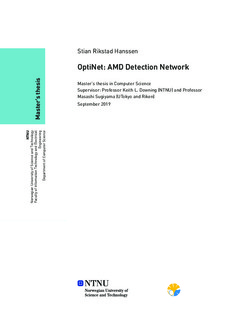| dc.contributor.advisor | Downing, Keith | |
| dc.contributor.advisor | Sugiyama, Masashi | |
| dc.contributor.author | Hanssen, Stian Rikstad | |
| dc.date.accessioned | 2019-11-06T15:02:31Z | |
| dc.date.available | 2019-11-06T15:02:31Z | |
| dc.date.issued | 2019 | |
| dc.identifier.uri | http://hdl.handle.net/11250/2627012 | |
| dc.description.abstract | Det medisinske fagfeltet utforsker flere og flere automatiske teknikker for å hjelpe fagpersoner i sitt arbeid. I de siste årene, har kunstige nevrale nettverk funnet suksess i et stort antall fagfelt med ytelse på likt nivå eller bedre enn mennesker. På grunn av dette, blir nevrale nettverk testet i et økende antall domener. Diagnose av øyesykdommer, som for eksempel \textit{aldersrelatert makuladegenerasjon} (AMD), er et av disse domenene. En svært utbredt sykdom kjent som den største årsaken til irreversibel synshemming i høyinntektsland. AMD er vanligvis diagnostisert gjennom analyse av medisinske bilder slik som \textit{optisk koherens tomografi} (OCT). Denne visuelle analysen er en oppgave som ofte er passende for \textit{konvolusjonsbaserte nevrale nettverk} (CNN). Mange eksperimenter som bruker CNNs har blitt gjennomførst på grunn av dette, og de viser lovende resultater.
Jeg foreslår en CNN arkitektur for OCT bilder som yter på det høyeste nivå i verden på gjenkjenning av AMD. Arkitekturen er testet med to forskjellige konvolusjonstyper: Vanlig 3D konvolusjon og en dekomposisjon av 3D konvolusjon kjent som "spatiotemporal" konvolusjon. Ulikt mange fremgangsmåter i litteraturen, min modell trenger ingen pre-trening, samtidig som den oppnår AUC på $\sim99.7\%$ på et datasett fra Duke Universitet, og en AUC på $\sim99.9\%$ på et nytt dataset fra St. Olavs Universitetssykehus. I tillegg blir resultatene undersøkt med bruk av CNN Fixations, en visualiseringteknikk som kan avsløre hva modellen fokuserer på i OCT bildene. | |
| dc.description.abstract | The field of medicine is exploring increasingly more automated techniques to aid professionals in their work. In recent years, a surge of artificial neural networks has found success in a wide range of fields, performing comparable or even better than humans. Because of this, neural networks are currently being tested in an increasing number of domains. Diagnosis of eye conditions such as \textit{age-related macular degeneration} (AMD) is one such example. A highly rampant disease known for being the biggest cause of irreversible visual impairment in high-income countries. AMD is commonly diagnosed by analysis of medical images such as \textit{optical coherence tomography} (OCT). This visual analysis is a task often suitable for \textit{convolutional neural networks} (CNNs). Therefore, many experiments using CNNs have been conducted and they show promising results.
I propose a CNN architecture for OCT scans that perform at a state-of-the-art level when detecting AMD. The architecture is tested using two kinds of convolution: Regular 3D convolution and a decomposition of 3D convolutions known as spatiotemporal convolution. Unlike many approaches in the literature, the model requires no pre-training, while achieving an AUC of $\sim99.7\%$ on the dataset from Duke University, and an AUC of $\sim99.9\%$ on a new dataset from St. Olav's University Hospital. Furthermore, the results are examined using CNN Fixations, a visualization technique that can reveal what the model focused on in the OCT scans. | |
| dc.language | eng | |
| dc.publisher | NTNU | |
| dc.title | OptiNet: AMD Detection Network | |
| dc.type | Master thesis | |
